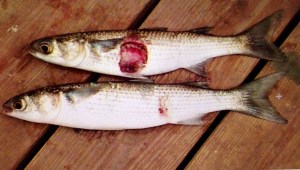Port Mayaca, Structure S-308 at Lake Okeechobee opens to Canal-44 into St Lucie River. S-308 is open for water supply for agriculture but is not going through S-80 into the St Lucie River/ Indian River Lagoon. Aerial, Ed Lippisch, 5-5-21.
River Warrior Times 5-16-21. This piece is written specially for Lake Okeechobee.
It was my intension to write a summary water piece every two weeks. I last wrote on April 25, 2021.Today, I will try to catch up.
If I had one phrase to describe what has happened since April 25, it would be “high-alert.” Governor DeSantis visited on May 10, giving direction as his executive order 19-12 is the guidepost for the Department of Environmental Protection and the SFWMD.
The blue-green algae bloom at Pahokee Marina, I wrote about last time, was cleaned up through a cooperative of the South Florida Water Management District and the Department of Environmental Protection. This is a first as globs of purple, blue, green, and grey cyanobacteria -blue green algae- sat in marinas and inside canal communities in 2016, and 2018 until they rotted and fell to the bottom. This time, under Governor DeSantis of which DEP and the SFMWD sit organizationally, it was determined (under Section 1 part I of 19-12) to remove the toxic algae via vacuum and chemical treatment, relocating what Palm Beach County could not take safely, far away to District lands away from people and wildlife.
Keith W. Babb, Mayor of Payhokee, attend the May 13 SFWMD Governing Board meeting and was very grateful. You can listen to his comments at 39.00 the beginning of the meeting. Congressman Brian Mast, who led Governor DeSantis’ transition committee, also provided fiery commentary.
Although it is definitely a positive that the toxic algae was removed, we must ask ourselves a question. How are we going to pay for this again, and again, and again? A precedent has been set. Is vacuuming each time sustainable? With Lake Okeechobee in its present condition this is a very relevant question.
As Mark Perry, the Executive Director of Florida Oceanographic has repeatedly stated: “Unless we address the source of the problem in the upper watershed of Lake Okeechobee, we will never reach the 105 metric tons at 40 ppb.” Translated, that means the pollution numbers coming into the lake are high, in some basins over 600 parts per billion phosphorus. You can’t vacuum away as an avalanche of pollution pours in!
The situation is complex. However, the handling of Pahokee Marina is symbolic of a larger problem. I would have liked not only DEP and SFWMD to be in the spotlight at the Pahokee Marina, but also FDASCs the Florida Department of Agriculture and Consumer Services. Why? Because the lake did not get sick overnight, and the history of Lake Okeechobee is an agricultural one. This is reflected in “who” is in charge of water quality.
First, back-pumping fertilized and chemical-leaden water into Lake Okeechobee was common practice and allowed by the by the state. The sugar industry/EAA imparticularly partook of this practice for decades. It almost killed the lake. In the 1970s and 1980s lawsuits forced water that was once back-pumped into Lake Okeechobee to flow south, sparing the lake, but creating a new issue of destroying the Everglades. This in turn spurred other lawsuits so that today Everglades Agriculture Area (EAA) runoff must first be filtered through Storm Water Treatment Areas, south of Lake Okeechobee before it can enter the Everglades Protection Areas or Everglades National Park. Most of this was paid for by taxpayers, just like the clean up at Pahokee Marina.

Lake Okeechobee, though in a better position than in 1970 continues to be fed high concentrations of phosphorus and nitrogen mostly from agriculture areas north of Lake Okeechobee. Thus destruction already done from the early years is locked up in sediments, and the new destruction that continues makes for a hyper-eutropic lake that now blooms every year.
Not a good situation. So how is fixing our waters supposed to work? Who is in charge of water quality?
“The Northern Everglades and Estuaries Protection Program (373,4595. Florida Statutes) directs the Florida Department of Environmental Protection, the Florida Department of Agriculture and Consumer Services, and the South Florid aWater Management District to work together to reduce pollutants and achieve water quality standards in the the Lake Okeechobee, St Lucie River, and Caloosahatchee River watershed through Basin Management Action Plans and Total Maximum Daily Loads program (403.067. Florida Statutes.)”
No one agency is in charge of water quality. Like it or not, in Florida, three agencies have this responsibility. As Florida Statue requires, we must all work together to turn Florida’s organizational chart from a line into a triangle. Until FDEP, SFWMD & FACS are truly working together, there will not be improvement to Lake Okeechobee’s water quality and Florida’s tax payers will be on the hook.
THE TRIANGLE!
–Organizational chart State of Florida. Note the members of The Triangle (circled) responsible of water quality. The Dept. of Ag is a cabinet position. DEP and SFWMD are lower agencies but fall under the top tier, the governor. The governor is doing a great job but he can not do it alone! 
Links to timely information:
JAX ACOE keeps S-80 closed, adjust flows to Caloosahatchee
SFWMD operations statement Ops_Position_Statement_May_11_17_2021
EyeonLakeO website Todd Thurlow
DEP algae bloom dashboard
FOS SLR water quality report
Orca report on dead manatees in the IRL by county
































































